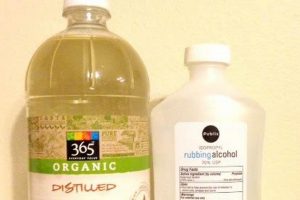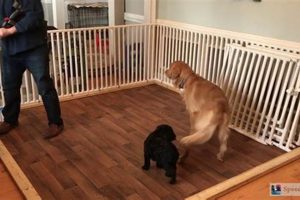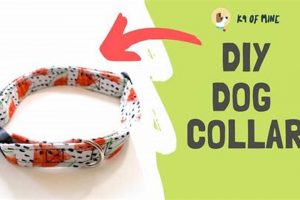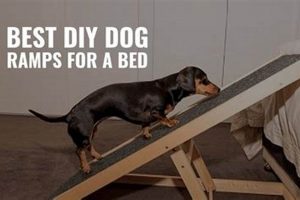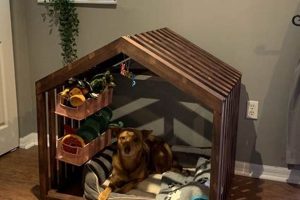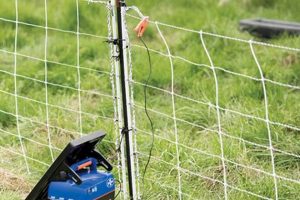A homemade enclosure concealment serves as a protective and aesthetic addition to a canine’s personal space. These custom creations typically involve fabric and basic sewing skills to transform a standard wire or plastic kennel into a more comfortable and visually appealing den for the animal. For example, an individual might construct one using patterned canvas and Velcro closures to match their home dcor, offering both privacy and a decorative touch.
The advantages of these handcrafted items are multifaceted. They provide the dog with a sense of security by minimizing external stimuli, which can be especially beneficial for anxious or easily excitable animals. Furthermore, these coverings can regulate temperature by blocking drafts in the winter and providing shade in the summer. Historically, crate covers were primarily functional, but modern designs prioritize both practicality and aesthetics, integrating seamlessly into contemporary living spaces.
The following sections will detail the necessary materials, construction methods, and design considerations for creating a personalized and functional enclosure concealment. Attention will be given to safety, durability, and the individual needs of the canine occupant.
Construction Strategies
The following guidelines offer essential advice for ensuring the successful creation of a robust and aesthetically pleasing kennel concealment.
Tip 1: Accurate Measurement is Paramount. Prior to any material selection or cutting, meticulous measurement of the kennel dimensions is crucial. Inaccurate measurements can result in a cover that is either too tight or too loose, compromising both functionality and appearance. Re-measure multiple times for verification.
Tip 2: Material Selection for Durability. Opt for fabrics that are both durable and washable. Heavy-duty canvas, denim, or upholstery-grade materials offer resistance to wear and tear from canine activity. Consider pre-washing the fabric to prevent shrinkage after the cover is completed.
Tip 3: Prioritize Canine Safety. Avoid the use of small parts, such as buttons or delicate embellishments, which could pose a choking hazard. Ensure that any ties or closures are securely fastened and of sufficient length to prevent entanglement.
Tip 4: Ventilation is Essential. Incorporate ventilation openings in the design to ensure adequate airflow within the kennel. Mesh panels or strategically placed openings can prevent overheating and maintain a comfortable environment for the animal.
Tip 5: Secure Fastening Mechanisms. Implement reliable fastening mechanisms, such as zippers, Velcro closures, or sturdy ties, to keep the cover securely in place. Ensure that the dog cannot easily dislodge or damage these mechanisms.
Tip 6: Consider Washability and Maintenance. Design the cover with ease of cleaning in mind. Removable panels or a fully machine-washable design will simplify maintenance and prolong the lifespan of the product.
These tips emphasize the importance of precision, durability, and safety when embarking on the construction of a kennel concealment. Adherence to these guidelines will contribute to a functional and aesthetically pleasing addition to the canine’s living space.
The final section of this article will delve into advanced design considerations and customization options for those seeking to elevate their kennel concealment projects.
1. Measurement Accuracy
Measurement accuracy is a foundational element in the creation of a functional and aesthetically pleasing homemade canine enclosure concealment. Deviations from precise dimensions can compromise the cover’s fit, potentially leading to discomfort for the animal and a visually unappealing outcome. The following outlines key facets of measurement accuracy within this context.
- Initial Dimensional Assessment
The initial step involves accurately measuring the exterior dimensions of the kennel. This includes length, width, and height at multiple points to account for any potential irregularities in the kennel’s structure. Neglecting this step can result in a cover that is either too tight to properly enclose the kennel or too loose, rendering it ineffective at providing privacy or temperature regulation. Example: If the height measurement is underestimated, the cover may not fully reach the ground, allowing drafts and visual distractions.
- Seam Allowance Considerations
Fabrication requires the incorporation of seam allowances, which are the extra material added to the cut edges to allow for stitching and prevent fraying. Inaccurate calculations of seam allowances can lead to significant discrepancies in the final dimensions of the cover. Example: A consistent error of 0.5 inches per seam across multiple seams can accumulate, resulting in a cover that is several inches smaller than intended.
- Accounting for Closure Mechanisms
The design must incorporate closure mechanisms such as zippers, Velcro, or ties. Accurate measurements are essential to ensure these closures align correctly and function as intended. Example: If the placement of Velcro strips is miscalculated, the cover may not close securely, leaving gaps that compromise privacy and temperature control.
- Pattern Creation and Prototyping
Creating a pattern based on accurate measurements is critical for consistent results. Prototyping, even with inexpensive fabric, allows for verification of the pattern’s accuracy before committing to the final material. Example: A paper or muslin prototype can reveal dimensional errors or design flaws that would be costly to rectify on the final product.
The foregoing illustrates the interconnectedness of accurate measurements and the success of creating a kennel concealment. Neglecting any of these facets can lead to a final product that fails to meet functional and aesthetic requirements. Prioritizing precise measurement techniques is, therefore, indispensable for a satisfactory outcome.
2. Material Durability
Material durability is a critical factor determining the longevity and functionality of a homemade canine enclosure shield. The selection of robust materials directly influences the cover’s resistance to wear and tear caused by the animal’s activities, such as scratching, chewing, and general movement. A durable fabric ensures that the cover maintains its structural integrity and aesthetic appeal over time. For example, a cover constructed from heavy-duty canvas or tightly woven denim will withstand significantly more abuse than one made from a lightweight, loosely woven material. The practical effect of choosing a less durable material is premature wear, necessitating frequent repairs or replacement, thus increasing the overall cost and effort associated with maintaining the kennel environment.
Furthermore, the type of closure mechanisms employed, and their method of attachment, significantly impact overall durability. Zippers, Velcro closures, or ties must be constructed from resilient materials and securely affixed to the fabric to prevent detachment or breakage under stress. Reinforced stitching along seams and stress points further enhances the cover’s ability to withstand rigorous use. A real-life example includes a cover where the Velcro closures are stitched with a high-tensile strength thread, preventing them from tearing away from the fabric even with repeated use and the dog pulling on the cover. Consequently, the practical significance of understanding material durability extends beyond the fabric itself to encompass all components integral to the cover’s construction.
In summary, material durability constitutes a cornerstone of successful kennel concealment construction. The selection of appropriate materials, coupled with robust construction techniques, directly impacts the cover’s lifespan, functionality, and the overall well-being of the enclosed canine. The challenge lies in balancing the need for durability with other considerations, such as aesthetic appeal and ease of cleaning, to create a product that satisfies both the practical and aesthetic requirements of the owner and the comfort and safety of the animal.
3. Ventilation Adequacy
Ventilation adequacy represents a critical, often overlooked, aspect of constructing a homemade canine enclosure concealment. It directly impacts the animal’s health and well-being by regulating temperature, minimizing humidity, and ensuring a supply of fresh air within the confined space.
- Thermal Regulation
Insufficient ventilation can lead to overheating, particularly in warmer climates or during summer months. Canines are less efficient at dissipating heat than humans, making them susceptible to heatstroke. A well-ventilated cover allows for the circulation of air, preventing the buildup of excessive heat. For example, mesh panels strategically placed on the sides and top of the cover facilitate airflow, ensuring a comfortable temperature range within the kennel.
- Humidity Control
Respiration and perspiration contribute to increased humidity levels within an enclosed space. High humidity can create a breeding ground for bacteria and fungi, potentially leading to respiratory issues or skin infections. Adequate ventilation removes excess moisture, maintaining a drier and healthier environment. An illustration includes the implementation of ventilation openings near the base of the cover to allow heavier, moisture-laden air to escape.
- Air Quality Maintenance
The accumulation of exhaled carbon dioxide and other metabolic waste products can degrade air quality within the kennel. Stagnant air can also trap odors, creating an unpleasant environment for both the animal and the owner. Adequate ventilation promotes the exchange of stale air with fresh air, ensuring a constant supply of oxygen and reducing the concentration of harmful substances. A practical example is the incorporation of a chimney-like vent at the top of the cover to facilitate the upward flow of stale air.
- Material Permeability
The choice of material for the kennel concealment directly influences ventilation adequacy. Impermeable materials, such as vinyl or tightly woven fabrics, restrict airflow, potentially exacerbating the issues mentioned above. Breathable materials, such as canvas or loosely woven cotton, allow for some degree of natural ventilation, even without dedicated ventilation openings. The selection of a breathable material, in conjunction with strategic vent placement, optimizes ventilation within the kennel.
In conclusion, ventilation adequacy is not merely a secondary consideration but a fundamental requirement for a responsible approach to canine enclosure concealment construction. Ignoring this aspect can have detrimental effects on the animal’s health and comfort, negating the intended benefits of providing a secure and private space. Therefore, careful planning and implementation of ventilation strategies are essential for ensuring a safe and healthy environment within the kennel.
4. Safety Provisions
Safety provisions are paramount in the construction of a homemade canine enclosure concealment. The potential for unintended harm necessitates a comprehensive consideration of materials, design, and construction techniques. A failure to prioritize safety can lead to injury, illness, or even death of the animal.
- Non-Toxic Materials
The selection of materials must prioritize the absence of toxic substances. Fabrics treated with harmful chemicals, paints containing lead, or adhesives that emit volatile organic compounds (VOCs) pose a significant risk to canine health. Ingestion or prolonged exposure can lead to poisoning or allergic reactions. For example, opting for organic cotton fabrics and water-based, non-toxic paints mitigates the risk of chemical exposure. Certifications such as Oeko-Tex Standard 100 provide assurance that textiles have been tested for harmful substances.
- Secure Closure Mechanisms
Closure mechanisms, such as zippers, Velcro, or ties, must be designed and implemented to prevent accidental entanglement or ingestion. Loose strings or easily detachable components represent a choking hazard. Furthermore, poorly designed closures may allow the animal to escape the kennel, potentially leading to injury or becoming lost. A practical example is the use of heavy-duty zippers with locking sliders and reinforced stitching to prevent the dog from opening the enclosure or detaching the zipper pull. Velcro closures should be securely sewn and of sufficient size to prevent easy removal.
- Adequate Ventilation
As previously discussed, adequate ventilation is essential for preventing overheating and maintaining air quality. Insufficient ventilation can lead to heatstroke, particularly in warm climates. Additionally, the accumulation of exhaled carbon dioxide can create a toxic environment within the kennel. The incorporation of mesh panels or strategically placed openings ensures continuous airflow and prevents the buildup of harmful gases. The size and placement of these vents should be carefully calculated based on the kennel’s dimensions and the expected environmental conditions.
- Absence of Protruding Hazards
The internal and external surfaces of the cover should be free of sharp edges, protruding wires, or other potential hazards that could cause injury. Exposed staples, improperly finished seams, or poorly attached embellishments represent a laceration risk. Thorough inspection of the finished product is necessary to identify and eliminate any such hazards. A practical mitigation strategy involves using rounded corners, concealed seams, and securely fastened embellishments to minimize the risk of injury.
The integration of these safety provisions is not merely a matter of best practice but a fundamental ethical obligation in the construction of a homemade canine enclosure concealment. A failure to prioritize safety represents a dereliction of responsibility and can have dire consequences for the animal’s well-being. Diligent planning, careful material selection, and meticulous construction techniques are essential for creating a safe and comfortable environment for the canine occupant.
5. Aesthetic Harmony
Aesthetic harmony, in the context of a homemade canine enclosure concealment, represents the seamless integration of the cover’s visual characteristics with the surrounding environment. This integration is not merely a matter of superficial appeal; it reflects a deeper consideration of how the canine’s space contributes to the overall aesthetic of the home. The absence of aesthetic harmony can result in a visually jarring element that detracts from the intended design of the living space. For instance, a brightly colored, cartoon-themed cover in a minimalist, modern living room would disrupt the carefully curated aesthetic, creating a visual discord.
The importance of aesthetic harmony stems from the desire to create a cohesive and visually pleasing living environment. A well-designed kennel concealment should complement the existing dcor, rather than competing with it. This can be achieved through careful selection of colors, patterns, and materials that align with the room’s existing style. For example, a cover made from neutral-toned linen or subtly patterned fabric can seamlessly blend into a room with a traditional or contemporary aesthetic. Real-life applications of this principle include crafting covers that match the color of the sofa, incorporate patterns found in existing rugs, or utilize materials that complement the room’s architectural features. Achieving this harmony elevates the kennel from a purely functional item to a contributing element of the home’s design.
Challenges in achieving aesthetic harmony arise from balancing personal preferences with broader design principles. While individual taste plays a role, it is essential to consider the overall impact of the cover on the room’s aesthetic. Furthermore, maintaining aesthetic harmony requires ongoing consideration as the home’s dcor evolves. A cover that once blended seamlessly with the environment may become visually incongruous after a redecorating project. In summary, aesthetic harmony is a critical, albeit often subtle, component of a homemade canine enclosure concealment. Successfully achieving this harmony requires careful planning, thoughtful material selection, and an awareness of the broader design context, resulting in a functional and visually pleasing addition to the home.
Frequently Asked Questions
This section addresses common inquiries regarding the construction and use of homemade canine enclosure concealments. The information provided aims to clarify concerns and offer practical guidance.
Question 1: What materials are most suitable for constructing a durable canine enclosure concealment?
Heavy-duty fabrics such as canvas, denim, and upholstery-grade materials offer superior resistance to wear and tear. These fabrics should be tightly woven and, ideally, pre-shrunk to minimize dimensional changes after washing. The selection must also consider canine chewing habits and the potential for damage. Flame-resistant materials are recommended to enhance safety.
Question 2: How can adequate ventilation be ensured when using a DIY canine enclosure concealment?
Ventilation can be achieved through the strategic placement of mesh panels or openings within the cover’s design. These openings should be sized and positioned to promote cross-ventilation, allowing for the exchange of stale air with fresh air. The location and size of ventilation apertures must be calibrated based on kennel dimensions and environmental conditions.
Question 3: What safety precautions are essential when constructing a homemade canine enclosure concealment?
Safety precautions include the use of non-toxic materials, secure closure mechanisms, and the elimination of potential hazards such as sharp edges or loose components. All materials should be free of harmful chemicals or dyes. Closure mechanisms must be designed to prevent entanglement or ingestion. Regular inspection for wear and tear is crucial.
Question 4: How can a DIY canine enclosure concealment be effectively cleaned and maintained?
Washable fabrics are recommended to facilitate cleaning. Removable panels or a fully machine-washable design simplifies maintenance. Regular washing helps to remove dirt, allergens, and odors. Drying the cover thoroughly prevents the growth of mold and mildew.
Question 5: How does a DIY canine enclosure concealment contribute to a canine’s sense of security?
The concealment provides a den-like environment, minimizing external stimuli and creating a sense of privacy. This can be particularly beneficial for anxious or easily excitable canines. The cover should be appropriately sized to allow the animal to stand, turn around, and lie down comfortably.
Question 6: What design considerations are important for ensuring a visually appealing DIY canine enclosure concealment?
Design considerations include the selection of colors, patterns, and materials that complement the surrounding environment. The cover should integrate seamlessly with the existing decor, rather than creating a visual discord. Customization options, such as embroidery or appliqus, can add a personal touch.
The information presented underscores the importance of careful planning, material selection, and construction techniques in creating a safe, functional, and aesthetically pleasing canine enclosure concealment.
The next section will explore advanced customization techniques for canine enclosure concealments.
DIY Dog Crate Cover
This discourse has comprehensively explored the construction of a diy dog crate cover, emphasizing the importance of accurate measurements, durable materials, adequate ventilation, stringent safety provisions, and aesthetic harmony. Each element contributes significantly to the creation of a secure, comfortable, and visually integrated canine habitat. The discussed methods and considerations provide a framework for informed decision-making during the construction process.
The creation of a diy dog crate cover represents a commitment to canine well-being and responsible pet ownership. The effectiveness of any such project depends upon the rigorous application of the principles outlined herein. Continued research and refinement of construction techniques will further enhance the functionality and safety of these essential canine accessories. The pursuit of excellence in this endeavor directly benefits the animals under our care.


